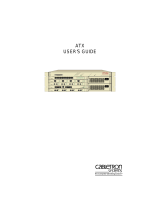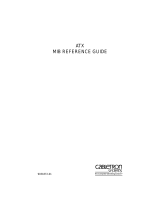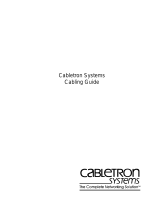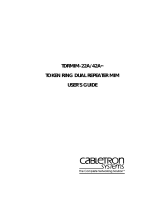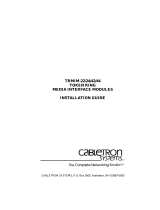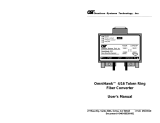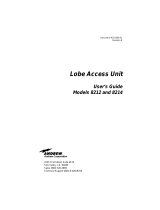Page is loading ...

TOKEN RING SWITCH MODULE
(3T02-04 AND 3T01-04)
USER GUIDE
9031875-01
OFFLINE
RING 1
RX ST
RING 2
RX ST
RING 3
RX ST
RING 4
RX ST PROC
TX 16 TX 16 TX 16 TX 16 PWR
QUAD IEEE 802.5 TOKEN RING (STP)
OFFLINE
RING 1
RX ST
RING 2
RX ST
RING 3
RX ST
RING 4
RX ST PROC
TX 16 TX 16 TX 16 TX 16 PWR
QUAD IEEE 802.5 TOKEN RING (UTP)


Token Ring Switch Module User Guide i
NOTICE
Cabletron Systems reserves the right to make changes in specifications and other information
contained in this document without prior notice. The reader should in all cases consult Cabletron
Systems to determine whether any such changes have been made.
The hardware, firmware, or software described in this manual is subject to change without notice.
IN NO EVENT SHALL CABLETRON SYSTEMS BE LIABLE FOR ANY INCIDENTAL,
INDIRECT, SPECIAL, OR CONSEQUENTIAL DAMAGES WHATSOEVER (INCLUDING BUT
NOT LIMITED TO LOST PROFITS) ARISING OUT OF OR RELATED TO THIS MANUAL OR
THE INFORMATION CONTAINED IN IT, EVEN IF CABLETRON SYSTEMS HAS BEEN
ADVISED OF, KNOWN, OR SHOULD HAVE KNOWN, THE POSSIBILITY OF SUCH
DAMAGES.
Copyright 1996 by Cabletron Systems, Inc., P.O. Box 5005, Rochester, NH 03866-5005
All Rights Reserved
Printed in the United States of America
Order Number: 9031875-01 May 1996
All other product names mentioned in this manual may be trademarks or registered trademarks of
their respective companies.
Printed on Recycled Paper

Notice
ii Token Ring Switch Module User Guide
FCC NOTICE
This device complies with Part 15 of the FCC rules. Operation is subject to the following two
conditions: (1) this device may not cause harmful interference, and (2) this device must accept any
interference received, including interference that may cause undesired operation.
NOTE:
This equipment has been tested and found to comply with the limits for a Class A digital
device, pursuant to Part 15 of the FCC rules. These limits are designed to provide reasonable
protection against harmful interference when the equipment is operated in a commercial environment.
This equipment uses, generates, and can radiate radio frequency energy and if not installed in
accordance with the operator’s manual, may cause harmful interference to radio communications.
Operation of this equipment in a residential area is likely to cause interference in which case the user
will be required to correct the interference at his own expense.
WARNING:
Changes or modifications made to this device which are not expressly approved by the
party responsible for compliance could void the user’s authority to operate the equipment.
DOC NOTICE
This digital apparatus does not exceed the Class A limits for radio noise emissions from digital
apparatus set out in the Radio Interference Regulations of the Canadian Department of
Communications.
Le présent appareil numérique n’émet pas de bruits radioélectriques dépassant les limites applicables
aux appareils numériques de la class A prescrites dans le Règlement sur le brouillage radioélectrique
édicté par le ministère des Communications du Canada.
VCCI NOTICE
This equipment is in the 1st Class Category (information equipment to be used in commercial and/or
industrial areas) and conforms to the standards set by the Voluntary Control Council for Interference
by Information Technology Equipment (VCCI) aimed at preventing radio interference in commercial
and/or industrial areas.
Consequently, when used in a residential area or in an adjacent area thereto, radio interference may be
caused to radios and TV receivers, etc.
Read the instructions for correct handling.

Notice
Token Ring Switch Module User Guide iii
CABLETRON SYSTEMS, INC. PROGRAM LICENSE AGREEMENT
IMPORTANT:
Before utilizing this product, carefully read this License Agreement.
This document is an agreement between you, the end user, and Cabletron Systems, Inc. (“Cabletron”)
that sets forth your rights and obligations with respect to the Cabletron software program (the
“Program”) contained in this package. The Program may be contained in firmware, chips or other
media. BY UTILIZING THE ENCLOSED PRODUCT, YOU ARE AGREEING TO BECOME
BOUND BY THE TERMS OF THIS AGREEMENT, WHICH INCLUDES THE LICENSE AND
THE LIMITATION OF WARRANTY AND DISCLAIMER OF LIABILITY. IF YOU DO NOT
AGREE TO THE TERMS OF THIS AGREEMENT, PROMPTLY RETURN THE UNUSED
PRODUCT TO THE PLACE OF PURCHASE FOR A FULL REFUND.
CABLETRON SOFTWARE PROGRAM LICENSE
1. LICENSE
. You have the right to use only the one (1) copy of the Program provided in this
package subject to the terms and conditions of this License Agreement.
You may not copy, reproduce or transmit any part of the Program except as permitted by the
Copyright Act of the United States or as authorized in writing by Cabletron.
2. OTHER RESTRICTIONS. You may not reverse engineer, decompile, or disassemble the
Program.
3. APPLICABLE LAW. This License Agreement shall be interpreted and governed under the laws
and in the state and federal courts of New Hampshire. You accept the personal jurisdiction and
venue of the New Hampshire courts.
EXCLUSION OF WARRANTY AND DISCLAIMER OF LIABILITY
1. EXCLUSION OF
WARRANTY. Except as may be specifically provided by Cabletron in
writing, Cabletron makes no warranty, expressed or implied, concerning the Program (including
its documentation and media).
CABLETRON DISCLAIMS ALL WARRANTIES, OTHER THAN THOSE SUPPLIED TO
YOU BY CABLETRON IN WRITING, EITHER EXPRESSED OR IMPLIED, INCLUDING
BUT NOT LIMITED TO IMPLIED WARRANTIES OF MERCHANTABILITY AND
FITNESS FOR A PARTICULAR PURPOSE, WITH RESPECT TO THE PROGRAM, THE
ACCOMPANYING WRITTEN MATERIALS, AND ANY ACCOMPANYING HARDWARE.
2. NO LIABILITY FOR CONSEQUENTIAL DAMAGES. IN NO EVENT SHALL
CABLETRON OR ITS SUPPLIERS BE LIABLE FOR ANY DAMAGES WHATSOEVER
(INCLUDING, WITHOUT LIMITATION, DAMAGES FOR LOSS OF BUSINESS,
PROFITS, BUSINESS INTERRUPTION, LOSS OF BUSINESS INFORMATION, SPECIAL,
INCIDENTAL, CONSEQUENTIAL, OR RELIANCE DAMAGES, OR OTHER LOSS)
ARISING OUT OF THE USE OR INABILITY TO USE THIS CABLETRON PRODUCT,
EVEN IF CABLETRON HAS BEEN ADVISED OF THE POSSIBILITY OF SUCH
DAMAGES. BECAUSE SOME STATES DO NOT ALLOW THE EXCLUSION OR
LIMITATION OF LIABILITY FOR CONSEQUENTIAL OR INCIDENTAL DAMAGES, OR
ON THE DURATION OR LIMITATION OF IMPLIED WARRANTIES, IN SOME
INSTANCES THE ABOVE LIMITATIONS AND EXCLUSIONS MAY NOT APPLY TO
YOU.

Notice
iv Token Ring Switch Module User Guide
UNITED STATES GOVERNMENT RESTRICTED RIGHTS
The enclosed product (a) was developed solely at private expense; (b) contains “restricted computer
software” submitted with restricted rights in accordance with Section 52227-19 (a) through (d) of the
Commercial Computer Software - Restricted Rights Clause and its successors, and (c) in all respects
is proprietary data belonging to Cabletron and/or its suppliers.
For Department of Defense units, the product is licensed with “Restricted Rights” as defined in the
DoD Supplement to the Federal Acquisition Regulations, Section 52.227-7013 (c) (1) (ii) and its
successors, and use, duplication, disclosure by the Government is subject to restrictions as set forth in
subparagraph (c) (1) (ii) of the Rights in Technical Data and Computer Software clause at 252.227-
7013. Cabletron Systems, Inc., 35 Industrial Way, Rochester, New Hampshire 03867-0505.

Token Ring Switch Module User Guide v
CONTENTS
CHAPTER 1 INTRODUCTION
1.1 Document Conventions...............................................................1-2
1.2 Related Manuals..........................................................................1-3
1.3 Getting Help.................................................................................1-3
1.4 General Description.....................................................................1-4
1.5 Standards....................................................................................1-5
1.6 Connectors..................................................................................1-5
1.7 LEDs............................................................................................1-6
CHAPTER 2 CONNECTING TO THE NETWORK
2.1 Introduction..................................................................................2-1
2.2 Power-up LED Sequence............................................................2-1
2.3 Typical Configurations.................................................................2-2
2.4 Connecting the Token Ring Module to a Hub..............................2-2
2.4.1 Unshielded Twisted Pair.................................................2-2
2.4.2 Shielded Twisted Pair.....................................................2-3
CHAPTER 3 CONFIGURING
3.1 Introduction..................................................................................3-1
3.2 Connecting the LCM....................................................................3-2
3.3 LCM Commands..........................................................................3-3
3.4 Setting the Ring Speed................................................................3-3
3.5 Configuring the Bridging Type.....................................................3-4
3.5.1 Transparent ....................................................................3-4
3.5.2 Source Routing and SRT................................................3-4
3.5.2.1 Bridging Method.............................................3-4
3.5.2.2 Segment Number...........................................3-5
3.5.2.3 Bridge Number...............................................3-5
3.6 Translation Options .....................................................................3-5
3.6.1 ARP Translation..............................................................3-6
3.6.2 Source Routing ARP Translation....................................3-7
3.6.3 IPX Translation ...............................................................3-7
3.6.4 AppleTalk Translation.....................................................3-9
CHAPTER 4 STATISTICS
4.1 Displaying Port Status.................................................................4-1
4.2 Module Statistics .........................................................................4-4

Contents
vi Token Ring Switch Module User Guide
CHAPTER 5 DIAGNOSTICS AND TROUBLESHOOTING
5.1 Power-up Diagnostics..................................................................5-1
5.1.1 Power-up Tests...............................................................5-1
5.1.2 Power-up Results............................................................5-2
5.2 Operational Diagnostics...............................................................5-2
5.2.1 Loopback Tests...............................................................5-2
5.2.2 Diagnostic Results...........................................................5-3
5.3 Troubleshooting ...........................................................................5-3
5.3.1 If the Module Fails to Power Up......................................5-3
5.3.2 Connectivity Problems.....................................................5-4
CHAPTER 6 ADDING/SWAPPING MODULES
6.1 Unpacking the Token Ring Switch Module ..................................6-1
6.2 Adding a Token Ring Switch Module...........................................6-1
6.3 Swapping a Module .....................................................................6-3
APPENDIX A TECHNICAL SPECIFICATIONS
APPENDIX B BRIDGING METHODS
B.1 Overview..................................................................................... B-1
B.2 Transparent Bridging ..................................................................B-2
B.3 Source Routing Bridging............................................................. B-3
B.4 Source Routing Transparent Bridging......................................... B-5
INDEX

Token Ring Switch Module User Guide Page 1-1
CHAPTER 1
INTRODUCTION
This manual is for system administrators responsible for configuring,
monitoring and maintaining the ATX. It should be used with the
ATX User
Guide
and the
ATX MIB User Guide
. The contents of each chapter are
described below.
• Chapter 1,
Introduction
, provides general descriptions of the
modules.
• Chapter 2,
Connecting to the Network
, describes how to physically
attach the modules to a Token Ring network.
• Chapter 3,
Configuring
, discusses the software configuration options
for the modules.
• Chapter 4,
Statistics
, provides information on Token Ring port
statistics.
• Chapter 5,
Diagnostics and Troubleshooting
, discusses identifying
possible problems with the modules.
• Chapter 6,
Adding/Swapping Modules
, gives instructions for adding
and replacing Token Ring modules.
• Appendix A,
Technical Specifications
, lists the pertinent technical
information about the modules.
• Appendix B,
Bridging Methods
, discusses transparent, source
routing, and source routing transparent bridging.

Chapter 1:
Introduction
Page 1-2 Token Ring Switch Module User Guide
1.1 DOCUMENT CONVENTIONS
The following conventions are used in presenting information in this
manual:
Commands, prompts, and information displayed by the computer appear
in Courier typeface:
Current Number of Station Addresses: 5
Current Number of Learned Addresses: 133
Number of Defined Filters: 4
Information that you enter appears in Courier bold typeface:
ATX >
status
Information that you need to enter with a command is enclosed in angle
brackets <>. For example, you must enter a <ring speed> for the selected
port:
ATX >
ringspeed <9 16>
In this example, the ring speed for port 9 is set to 16 megabits/second.
Field value options appear in bold typeface. For example, a filter type can
be either
Entry
or
Exit
.
NOTE
Note
symbol. Calls the reader’s attention to any item of
information that may be of special importance.
TIP
Tip
symbol. Conveys helpful hints concerning procedures or
actions.
!
CAUTION
Caution
symbol. Contains information essential to avoid
damage to the equipment.
Warning
symbol. Warns against an action that could result in
equipment damage, personal injury or death.

Related Manuals
Token Ring Switch Module User Guide Page 1-3
1.2 RELATED MANUALS
You may need to refer to the following documentation when you are using
a Token Ring module:
•
ATX User Guide
– contains installation and configuration instructions
for the ATX.
•
ATX MIB Reference Guide
– contains Cabletron’s enterprise MIB.
If you need internetworking reference material, you may find the
following books helpful:
•
Interconnections, Bridges and Routers,
Radia Perlman, Addison
Wesley
1992.
•
Internetworking with TCP/IP: Protocols, and Architecture
(2nd
edition), Volumes I and II, Douglas Comer, Prentice Hall
1991.
•
The Simple Book, An Introduction to Management of TCP/IP-based
Internets,
Marshall T. Rose, Prentice Hall
1991.
1.3 GETTING HELP
If you need additional support related to this device, or if you have any
questions, comments, or suggestions concerning this manual, contact
Cabletron Systems Technical Support:
By phone (603) 332-9400
Monday – Friday; 8
A
.
M
. – 8
P
.
M
. Eastern Time
By CompuServe GO CTRON from any ! prompt
By Internet mail [email protected]
By FTP ctron.com (134.141.197.25)
Login
anonymous
Password
your email address

Chapter 1:
Introduction
Page 1-4 Token Ring Switch Module User Guide
1.4 GENERAL DESCRIPTION
Cabletron Systems 3T01-04 and 3T01-02 modules connect the ATX to a 4
or 16 Mbps Token Ring network. The modules enable connectivity to
FDDI, Ethernet, and Token Ring Networks, and can be configured to
support Transparent Spanning Tree, Source Route, or Source Routing
Transparent Bridging. The ATX is also able to translate higher level
protocols to allow communication between end-user devices on Token
Ring and end-user devices on FDDI or Ethernet. Protocols translated
include: TCP/IP, Novell NetWare, and AppleTalk Phase II.
The Token Ring module ports can be connected to one Token Ring
network. The module contains connectors for shielded twisted pair (STP)
and unshielded twisted pair (UTP) cabling. Each module has eighteen
LEDs which indicate the current status of the module and the Token Ring
networks. The offline button allows you to remove the module for
swapping.
Up to four Token Ring networks can be attached to either module. The
module is available in two models: STP (3T01-04) and UTP (3T01-02).
Each module contains four connectors (STP or UTP), 18 status LEDs,
and an offline button.
The Token Ring module may be installed in any of the five interface slots
and the ATX can simultaneously support up to five Token Ring modules.
If five of either the 3T01-04 or 3T02-04 modules are installed, up to 20
networks can be connected.

Standards
Token Ring Switch Module User Guide Page 1-5
Figure 1-1 ATX Front Panel
1.5 STANDARDS
The physical and electrical characteristics of the Token Ring module
conform to the IEEE 802.5 standard. The protocol for the MAC layer is
specified by the IEEE 802.5 standard while that for the Logical Link
Layer is specified by the IEEE 802.2.
1.6 CONNECTORS
The Token Ring modules are available in versions for either UTP or STP
lobe cabling. The STP version of the four port Token Ring module has
four DB9 connectors; the UTP version has four RJ45 connectors. Power
for the module is provided by the ATX backplane.
Figure 1-2 3T02-04 and 3T01-04 Front Panels
POWER STATUS
ENGINE STATUS
TURBO STATUS
SUPPLY A
SUPPLY B
1.6 Gbps
RESET
PACKET PROCESSING ENGINE
NMS PORT
POWER
FastNET ATX
TM
OFFLINE
RING 1
RX ST
RING 2
RX ST
RING 3
RX ST
RING 4
RX ST PROC
TX 16 TX 16 TX 16 TX 16 PWR
QUAD IEEE 802.5 TOKEN RING (UTP)
OFFLINE
TX PWR
INTELLIGENT FDDI
RING A
RING B
THRU
WRAP
RX
PROC
FDDI MIC A FDDI MIC BOPTICAL BYPASS
MULTI-MODE MULTI-MODE
OFFLINE
PROCRX
TX
PWR
QUAD IEEE 802.3 / ETHERNET 10BASE2
SEGMENT 4SEGMENT 3SEGMENT 2 SEGMENT 1
RX
TX
RX
TX
RX
TX
OFFLINE
PROCRX
TX
PWR
QUAD IEEE 802.3 / ETHERNET 10BASE2
SEGMENT 4SEGMENT 3SEGMENT 2 SEGMENT 1
RX
TX
RX
TX
RX
TX
OFFLINE
RING 1
RX ST
RING 2
RX ST
RING 3
RX ST
RING 4
RX ST PROC
TX 16 TX 16 TX 16 TX 16 PWR
QUAD IEEE 802.5 TOKEN RING (STP)
OFFLINE
RING 1
RX ST
RING 2
RX ST
RING 3
RX ST
RING 4
RX ST PROC
TX 16 TX 16 TX 16 TX 16 PWR
QUAD IEEE 802.5 TOKEN RING (STP)
OFFLINE
RING 1
RX ST
RING 2
RX ST
RING 3
RX ST
RING 4
RX ST PROC
TX 16 TX 16 TX 16 TX 16 PWR
QUAD IEEE 802.5 TOKEN RING (STP)
OFFLINE
RING 1
RX ST
RING 2
RX ST
RING 3
RX ST
RING 4
RX ST PROC
TX 16 TX 16 TX 16 TX 16 PWR
QUAD IEEE 802.5 TOKEN RING (UTP)

Chapter 1:
Introduction
Page 1-6 Token Ring Switch Module User Guide
1.7 LEDs
Each Token Ring module provides 18 green LEDs for troubleshooting
and status monitoring. For each of the four Ring ports there are four LEDs
labeled RX, TX, ST, and 16. Additionally there are two module LEDs
labeled PROC and PWR. The LEDs are described in Chapter 5 of this
manual.

Token Ring Switch Module User Guide Page 2-1
CHAPTER 2
CONNECTING TO THE NETWORK
2.1 INTRODUCTION
Installation of a Token Ring network typically requires more planning and
explicit configuration than does a transparently-bridged Ethernet network.
This chapter provides reference material and instructions that network
administrators can use to configure the Token Ring modules.
For instructions on adding a Token Ring module to the ATX, see
Chapter 6,
Adding/Swapping Modules
.
2.2 POWER-UP LED SEQUENCE
Power up the ATX and observe the LED sequence. It takes about 1 minute
for the ATX to complete the power-up diagnostics. The ATX begins
system diagnostics on the PPE (topmost module) and then individually on
each installed module progressing from top to bottom.
The power-up LED sequence for the Token Ring module not attached to a
network is as follows:
1. All LEDs flash.
2. The POWER and 16 LEDs remain on.
3. After a few seconds the PROC LED comes on.
4. The ST LEDs come on.
5. The RX and TX LEDs flash briefly.
6. The ST and PROC LEDs go off.
7. The PROC LED comes on and the 16 LEDs go off.
8. The TX and RX LEDs flash briefly.
9. The Token Ring module then boots with the PROC and PWR LEDs
on.
10. All other LED activity beyond this point is a function of the
configuration and connection of the ATX.

Chapter 2:
Connecting to the Network
Page 2-2 Token Ring Switch Module User Guide
2.3 TYPICAL CONFIGURATIONS
Physical connectivity to a Token Ring network is provided by either
shielded twisted pair (STP) or unshielded twisted pair (UTP) cabling that
connects the Token Ring module to a Hub. Each Token Ring switch
module provides only one kind of connector, either four DB9 connectors
for STP cabling or four RJ45 connectors for UTP cabling.
2.4 CONNECTING THE TOKEN RING MODULE
TO A HUB
It is not possible to attach workstations directly to the ATX Token Ring
port. Either an active or a passive Hub must be used. A passive Hub
contains fairly simple electronics (principally relays) which form a
self-healing electrical ring. An active Hub contains more sophisticated
ring-maintenance circuitry and may be manageable.
2.4.1 Unshielded Twisted Pair
When using Unshielded Twisted Pair cabling in a Token Ring
environment, make sure that it conforms to the specifications in Table 2-1
(this assumes patch cables that are no longer than 8 feet or 2.4 meters):
a. To assure compatibility with future LANs, the longest lobe should be limited to
100 meters.
Table 2-1 Unshielded Twisted Pair Cabling Specifications
Data Rate Compatibility Cable Type Longest Lobe
a
4 Mbps
IBM and IEEE
UTP 802.5
Token Ring
EIA/TIA Category 3/4
EIA/TIA Category 5
100 m (328 ft.)
125 m (410 ft.)
16 Mbps
IBM and IEEE
UTP 802.5
Token Ring
EIA/TIA Category 3/4
EIA/TIA Category 5
45 m (147 ft.)
45 m (147 ft.)

Connecting the Token Ring Module to a Hub
Token Ring Switch Module User Guide Page 2-3
Refer to the Hub manufacturer’s manual for specific cabling information
for connecting workstations to the Hub.
To connect the Token Ring module to a UTP Hub, attach one end of a
UTP cable to the Token Ring module’s RJ45 connector and connect the
other end with the appropriate connector to any port
except
the Ring In or
Ring Out ports on a UTP Hub. The Ring In/Ring Out ports are used for
interconnecting Hubs. Refer to the example shown in Figure 2-1.
Figure 2-1 Connecting a Token Ring Module to a UTP Hub
2.4.2 Shielded Twisted Pair
When using Shielded Twisted Pair cabling, refer to the following (this
assumes patch cables that are no longer than 8 feet or 2.4 meters):
a. To assure compatibility with future LANs, the longest lobe should be limited to
100 meters.
Table 2-2 Shielded Twisted Pair Cabling Specifications
Data Rate Compatibility Cable Type Longest Lobe
a
4 Mbps
IBM and IEEE
802.5 Token
Ring
IBM Types 1 240 m (787 ft.)
16 Mbps
IBM and IEEE
802.5 Token
Ring
IBM Types 1 100 m (328 ft.)

Chapter 2:
Connecting to the Network
Page 2-4 Token Ring Switch Module User Guide
To connect to an STP MAU, attach the DB9 end of a Token Ring adapter
cable to the Token Ring module’s DB9 connector. Attach the Media
Interface Connector (MIC), on the other end of the cable, to any port
except
the Ring-In or Ring-Out ports on a STP MAU. The Ring-In/
Ring-Out ports are used for interconnecting MAUs. Refer to the example
shown in Figure 2-2.
Figure 2-2 Connecting a Token Ring Module to an STP MAU
OFFLINE
RING 1
RX ST
RING 2
RX ST
RING 3
RX ST
RING 4
RX ST PROC
TX 16 TX 16 TX 16 TX 16 PWR
QUAD IEEE 802.5 TOKEN RING (STP)
RI RO

Token Ring Switch Module User Guide Page 3-1
CHAPTER 3
CONFIGURING
3.1 INTRODUCTION
You can configure the Token Ring module using the Local Console
Manager (LCM), which allows you to monitor, manage, and configure
your ATX through an out-of-band RS-232 connection. You can also use
any SNMP compliant network management system.
For more details about LCM, see your
ATX User Guide
. For details about
the other network management software, refer to the product’s
documentation.
The following attributes are configurable using LCM:
• Speed of the Token Ring network (4 or 16 Mbps)
• Port's IP address for originating and receiving IP packets
• Enabling/disabling a port's Transparent Spanning Tree, Source
Routing or Source Routing Transparent mode
• Protocol translations
Additionally, the following attributes are configurable using network
management software (refer to the network management software
documentation for specific instructions):
• 48-bit unique MAC address
• Alarm thresholds for hardware errors
• Parameters for diagnostic loopback testing of a port
Filtering normally occurs as part of the Transparent Spanning Tree and
Source Routing algorithms. In addition, configurable criteria may be
established for filtering, to allow greater management control for security
or network congestion reasons. All configured filtering criteria are

Chapter 3:
Configuring
Page 3-2 Token Ring Switch Module User Guide
maintained in non-volatile memory and are saved across power cycles.
Filtering information is covered in the ATX User Guide.
After the ring speed is set, you may connect the module to a network and
then complete the software configuration, or you could complete all the
software configurations and then attach the module to a network.
3.2 CONNECTING THE LCM
Connect the Local Console Manager (LCM) to the ATX. Refer to
Chapter 2, Installation, of the ATX User Guide for specific instructions.
Make sure the ATX is powered on and press the <Return> key twice.
When the ATX> prompt appears LCM is ready to use.
3.3 LCM COMMANDS
Refer to the ATX User Guide for the generic LCM commands. Familiarize
yourself with LCM before configuring the module.
Specific instructions for setting the ring speed, enabling/disabling a port’s
bridging type, and translations for the Token Ring module follow in this
chapter.
If you are enabling IP routing, you need to assign addresses to the ports
which will be performing routing functions. Refer to the ATX User Guide
for instructions on assigning an IP address.
NOTE
Once the Token Ring module is installed in the ATX, the ring
speed must be configured prior to connecting the module to a
network. The default ring speed is 4 Mbps; the ring speed only
needs to be configured if your network is running at 16 Mbps.
/
